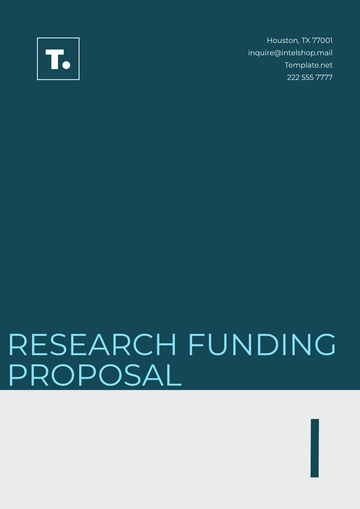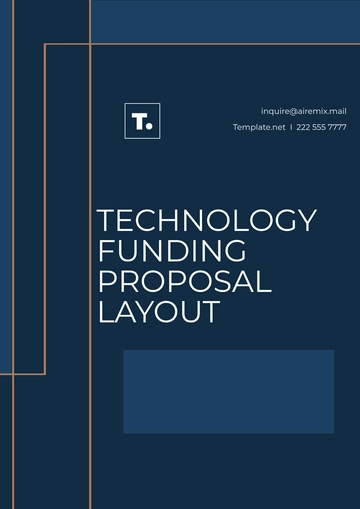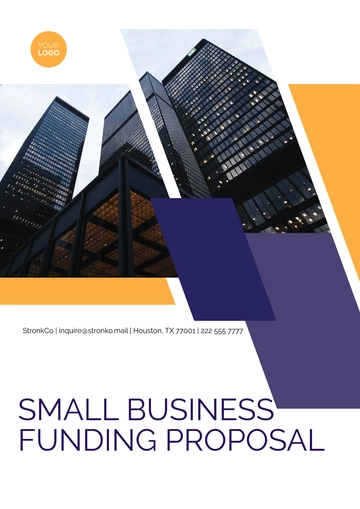Free Climate Change Funding Proposal

1. Executive Summary
Climate change remains the defining global challenge of the century. If left unaddressed, its effects will lead to irreversible damage to ecosystems, economies, and human livelihoods. The year 2050 serves as a critical deadline for concerted global actions to mitigate and adapt to these challenges. This proposal outlines a multifaceted approach by [Your Company Name] to tackle the crisis through renewable energy adoption, ecological restoration, sustainable agriculture, and public engagement.
By focusing on measurable objectives, [Your Company Name] aims to position itself as a leader in climate action, directly addressing the United Nations' Sustainable Development Goals (SDGs). The strategies presented prioritize environmental conservation, economic upliftment, and community empowerment.
The proposal requests funding of $[500 million] to initiate, implement, and sustain these ambitious projects. With the proper investment, these initiatives will yield a long-term reduction in greenhouse gas emissions, enhance biodiversity, and establish models for sustainable practices that other organizations and regions can emulate.
2. Introduction
2.1 Background
The year 2050 marks a tipping point in humanity’s response to the climate crisis. Climate models predict that without immediate action, global temperatures will rise by [2.5°C] above pre-industrial levels, intensifying natural disasters, disrupting food systems, and displacing millions. Despite decades of scientific warnings, current efforts remain insufficient to reverse these trends.
[Your Company Name] recognizes the moral and economic imperatives to act. Governments and private entities alike must collaborate to implement innovative, scalable, and equitable solutions. By combining renewable technologies, sustainable land use practices, and grassroots mobilization, [Your Company Name] is committed to creating a resilient future for communities worldwide.
2.2 Objectives
The objectives of this proposal reflect both short-term priorities and long-term aspirations. These include:
Energy Transformation: Shift at least [30%] of energy consumption to renewable resources by 2060, significantly reducing dependence on fossil fuels.
Land Rehabilitation: Restore [50,000 hectares] of degraded landscapes by 2055, creating ecological sanctuaries and carbon sinks.
Agricultural Innovation: Train and equip [10,000] farmers to adopt sustainable practices, ensuring food security amidst climate uncertainty.
Education and Advocacy: Reach [5 million] individuals by 2055 with awareness campaigns that promote climate resilience and sustainability.
These targets align with international benchmarks and reflect the commitment to tangible, community-focused outcomes.
3. Proposed Initiatives
3.1 Renewable Energy Projects
Renewable energy lies at the core of [Your Company Name]'s strategy. Transitioning to clean energy will significantly reduce carbon emissions while fostering energy security. The following projects are proposed:
Solar Power Expansion: Developing solar farms in regions with high sunlight availability. Each farm, capable of generating [500 MW], will reduce reliance on coal and gas plants, providing clean energy to [1 million] households annually. Solar farms will also include localized job creation for installation, operation, and maintenance.
Wind Energy Deployment: Offshore and onshore wind turbines will generate [800 GWh] of electricity annually, supporting industrial and residential needs. Community-driven ownership models will allow locals to share the financial benefits of wind energy development.
Grid Integration and Storage: Installing [200 MWh] of advanced battery storage systems ensures seamless integration of renewable sources into the energy grid. These systems will address intermittency issues and provide backup power during emergencies.
3.2 Reforestation and Land Restoration
Deforestation has contributed to an estimated [25%] of global emissions. By restoring degraded lands, [Your Company Name] aims to reverse this trend and enhance natural carbon capture.
Tree Planting Programs: Aiming to plant [20 million] trees by 2055, focusing on native and drought-resistant species. These trees will act as carbon sinks, absorbing [20 million tons] of CO2 by 2060.
Soil Restoration: Deploying techniques like biochar application and erosion control to improve soil quality across [50,000 hectares] of land. Healthy soil is critical for water retention, nutrient cycling, and supporting biodiversity.
Community-Led Initiatives: Engaging [1,000] local communities ensures projects reflect cultural values and benefit local populations. Training and financial incentives will empower residents to oversee conservation efforts.
3.3 Sustainable Agriculture
Agriculture accounts for nearly [10%] of greenhouse gas emissions globally. [Your Company Name] aims to mitigate this by transforming traditional farming methods into sustainable systems.
Drought-Resistant Crops: Distributing seeds for crops that require minimal water and are resilient to changing weather patterns. This strategy enhances food security and reduces the need for irrigation.
Agroforestry Practices: Combining agriculture with forestry by integrating trees into [15,000 hectares] of farmland. This approach diversifies income for farmers while capturing CO2 and improving soil health.
Precision Agriculture: Introducing technologies like drone surveillance, AI-powered irrigation systems, and weather forecasting tools to optimize resource use and minimize environmental impact.
3.4 Community Education and Engagement
Awareness and knowledge are powerful tools in climate action. This proposal emphasizes the importance of equipping individuals and communities with the skills to act.
Educational Campaigns: Running workshops in schools, universities, and workplaces to foster a culture of sustainability. By 2055, [5 million] individuals will have participated in these programs, creating a ripple effect in their communities.
Resource Hubs: Establishing [50] climate action hubs to serve as centers for innovation, training, and support. These hubs will host events, provide access to resources, and facilitate collaborations.
Media Outreach: Developing content for social media, television, and radio to reach broader audiences. The campaigns will highlight success stories, practical solutions, and urgent calls to action.
4. Financial Projections and Funding Needs
4.1 Budget Breakdown
Initiative | Estimated Cost ($) | Timeline |
|---|---|---|
Renewable Energy Projects | 200 million | 2051–2055 |
Reforestation and Land Restoration | 100 million | 2052–2058 |
Sustainable Agriculture | 150 million | 2051–2060 |
Community Education and Engagement | 50 million | 2051–2055 |
Total | 500 million |
4.2 Funding Sources
Funding for these projects will come from a combination of:
Government Support: Collaborating with national governments to access climate adaptation grants.
Corporate Partnerships: Partnering with organizations committed to corporate social responsibility (CSR).
Green Bonds: Issuing bonds designed for environmentally focused investors, ensuring long-term project sustainability.
Crowdfunding: Engaging the general public to contribute towards specific initiatives, fostering a sense of ownership and community.
5. Impact Assessment
5.1 Environmental Impact
The proposed initiatives address environmental challenges by targeting emissions reduction, biodiversity conservation, and sustainable resource use. Key impacts include:
Reduction in Greenhouse Gas Emissions: Transitioning to renewable energy sources like solar and wind will prevent the release of an estimated [50 million tons] of CO2 into the atmosphere by 2060. This initiative alone accounts for [30%] of the total emissions reduction goal.
Biodiversity Enhancement: Reforestation and habitat restoration projects will focus on native species, enhancing ecological balance and protecting endangered flora and fauna. Newly restored lands will increase green cover, improve ecosystem resilience, and provide shelter to over [500] species, some of which are critically endangered.
Mitigation of Land Degradation: With [50,000 hectares] of land restored, soil health will improve significantly. This will enhance water retention, reduce desertification risks, and stabilize areas prone to erosion.
Improved Air and Water Quality: Renewable energy sources will replace polluting fossil fuels, reducing air pollutants such as sulfur dioxide and nitrogen oxides. Agricultural practices like reduced pesticide use and biochar application will also contribute to cleaner water sources.
The collective environmental impact will create a ripple effect across ecosystems, ensuring sustainable use of resources for future generations.
5.2 Social and Economic Impact
In addition to ecological benefits, the proposal prioritizes societal well-being by creating opportunities for economic growth and community resilience.
Enhanced Livelihoods: Through renewable energy and sustainable agriculture projects, approximately [100,000] jobs will be created by 2060. These positions will span across installation, maintenance, project management, and training, with a focus on equitable inclusion of marginalized groups.
Community Empowerment: Education and engagement initiatives will foster local ownership of climate projects. By training [10,000] farmers and empowering community leaders, the proposal ensures that solutions are both sustainable and culturally relevant.
Improved Health and Well-Being: Reduced pollution levels and improved food security will enhance overall public health. Sustainable farming will lead to healthier diets and decreased reliance on processed foods, benefiting rural populations.
Economic Growth: The green economy is projected to grow exponentially in the coming decades. Investments in renewable energy, agroforestry, and education hubs will stimulate local economies, positioning regions as leaders in climate innovation.
The social and economic impacts are expected to create long-term resilience, reducing vulnerability to climate change and enhancing quality of life for millions.
6. Implementation Plan
6.1 Phased Execution
A phased approach is essential for managing resources effectively, ensuring community involvement, and delivering measurable results.
Phase 1: Planning and Pilot Programs (2051–2052)
Conduct baseline assessments to identify priority areas for intervention.
Establish partnerships with governments, NGOs, and private enterprises.
Pilot renewable energy installations, reforestation programs, and sustainable farming techniques in select regions to refine methodologies and assess feasibility.
Phase 2: Full-Scale Implementation (2053–2056)
Expand renewable energy projects to cover multiple regions, with a target of [500 MW] installed capacity by 2056.
Roll out large-scale tree planting programs to achieve [50%] of the reforestation target.
Train [5,000] farmers in sustainable practices and initiate widespread adoption of agroforestry methods.
Phase 3: Scaling and Evaluation (2057–2060)
Scale successful pilot projects to new regions and ecosystems.
Conduct evaluations of environmental, social, and economic outcomes to measure impact and refine strategies.
Transition project ownership to local governments, communities, and organizations to ensure sustainability and self-reliance.
6.2 Milestones
Milestone | Target Year |
|---|---|
Completion of baseline studies | 2052 |
Launch of pilot renewable energy projects | 2052 |
Reforestation of 25,000 hectares of land | 2055 |
Completion of community training for 10,000 farmers | 2056 |
Installation of 200 MW of renewable energy capacity | 2057 |
Overall emissions reduced by 20% | 2058 |
Full project completion | 2060 |
7. Monitoring and Evaluation
7.1 Key Performance Indicators (KPIs)
The success of this proposal will be monitored using clearly defined KPIs to ensure accountability and transparency.
Environmental KPIs:
Reduction in CO2 emissions by [30%] by 2060.
Increase in renewable energy capacity to [500 MW].
Restoration of [50,000 hectares] of degraded land.
Number of trees planted ([20 million] by 2055).
Social and Economic KPIs:
Number of jobs created ([100,000] by 2060).
Farmers adopting sustainable agricultural practices ([10,000]).
Individuals reached through educational initiatives ([5 million]).
Process KPIs:
Completion of feasibility studies within the first [2 years].
Timely disbursement of funding and resource allocation.
Community satisfaction levels, measured through surveys and feedback mechanisms.
7.2 Reporting Mechanisms
Regular reporting will ensure transparency and keep stakeholders informed. Mechanisms include:
Quarterly Progress Reports: Documenting project developments, challenges, and solutions.
Annual Sustainability Audits: Conducted by third-party evaluators to verify outcomes and adherence to environmental, social, and financial goals.
Public Dashboards: An interactive online platform accessible to stakeholders, showcasing real-time progress on various KPIs and milestones.
These mechanisms will enable adaptive management, ensuring that projects remain aligned with objectives and are equipped to address emerging challenges.
8. Conclusion
The climate crisis demands immediate and transformative action. Through this comprehensive proposal, [Your Company Name] aims to contribute meaningfully to global climate solutions. The proposed initiatives prioritize ecological restoration, economic development, and community resilience, creating a holistic approach to tackling the challenges of climate change.
By investing $[500 million], these projects will drive measurable impacts, including significant reductions in greenhouse gas emissions, restoration of degraded ecosystems, and empowerment of vulnerable communities. The emphasis on education and collaboration ensures that these solutions are not only effective but also sustainable in the long term.
As a leader in climate innovation, [Your Company Name] is poised to drive change and inspire others to join the movement for a healthier, more sustainable planet. With your support, this vision can become a reality, ensuring a future where humanity thrives in harmony with nature.
Together, let us forge a path toward a sustainable 2050 and beyond.
Appendices
Appendix A: Expanded Timeline
Phase | Year Range | Activities |
|---|---|---|
Phase 1: Planning | 2051–2052 | Feasibility studies, partnership building, pilot programs |
Phase 2: Implementation | 2053–2056 | Large-scale project rollout, community engagement |
Phase 3: Scaling and Evaluation | 2057–2060 | Expansion, monitoring, sustainability planning |
Appendix B: Environmental Data for Monitoring
Metric | Baseline Value | Target Value by 2060 |
|---|---|---|
CO2 Emissions (tons/year) | 80 million | 56 million |
Forest Cover (hectares) | 30,000 | 80,000 |
Renewable Energy Share (%) | 10% | 40% |
Appendix C: Comparative Case Studies
Country A: Achieved a [25%] reduction in emissions through solar and wind energy over [15 years].
Country B: Reforested [30,000 hectares] within [10 years], restoring critical wildlife habitats.
Country C: Implemented sustainable farming methods, increasing yields by [35%] while reducing water usage by [20%].
- 100% Customizable, free editor
- Access 1 Million+ Templates, photo’s & graphics
- Download or share as a template
- Click and replace photos, graphics, text, backgrounds
- Resize, crop, AI write & more
- Access advanced editor
Secure funding for your climate change initiatives with the Climate Change Funding Proposal Template from Template.net. This editable and customizable template helps you structure a compelling proposal to attract potential investors. Modify it easily using the AI Editor Tool. Download today to take action on climate change projects.
You may also like
- Business Proposal
- Research Proposal
- Proposal Request
- Project Proposal
- Grant Proposal
- Photography Proposal
- Job Proposal
- Budget Proposal
- Marketing Proposal
- Branding Proposal
- Advertising Proposal
- Sales Proposal
- Startup Proposal
- Event Proposal
- Creative Proposal
- Restaurant Proposal
- Blank Proposal
- One Page Proposal
- Proposal Report
- IT Proposal
- Non Profit Proposal
- Training Proposal
- Construction Proposal
- School Proposal
- Cleaning Proposal
- Contract Proposal
- HR Proposal
- Travel Agency Proposal
- Small Business Proposal
- Investment Proposal
- Bid Proposal
- Retail Business Proposal
- Sponsorship Proposal
- Academic Proposal
- Partnership Proposal
- Work Proposal
- Agency Proposal
- University Proposal
- Accounting Proposal
- Real Estate Proposal
- Hotel Proposal
- Product Proposal
- Advertising Agency Proposal
- Development Proposal
- Loan Proposal
- Website Proposal
- Nursing Home Proposal
- Financial Proposal
- Salon Proposal
- Freelancer Proposal
- Funding Proposal
- Work from Home Proposal
- Company Proposal
- Consulting Proposal
- Educational Proposal
- Construction Bid Proposal
- Interior Design Proposal
- New Product Proposal
- Sports Proposal
- Corporate Proposal
- Food Proposal
- Property Proposal
- Maintenance Proposal
- Purchase Proposal
- Rental Proposal
- Recruitment Proposal
- Social Media Proposal
- Travel Proposal
- Trip Proposal
- Software Proposal
- Conference Proposal
- Graphic Design Proposal
- Law Firm Proposal
- Medical Proposal
- Music Proposal
- Pricing Proposal
- SEO Proposal
- Strategy Proposal
- Technical Proposal
- Coaching Proposal
- Ecommerce Proposal
- Fundraising Proposal
- Landscaping Proposal
- Charity Proposal
- Contractor Proposal
- Exhibition Proposal
- Art Proposal
- Mobile Proposal
- Equipment Proposal
- Student Proposal
- Engineering Proposal
- Business Proposal





























